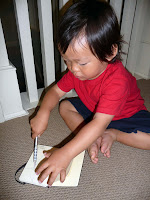
The
Faber Castell Red Line consists of several art supply products designed for children which oddly do not seem to have widespread distribution at retail in the USA despite their bright saturated colors and fun performance. From the
Faber Castell Malaysia website:
"Red Line" from Faber-Castell. A continuously growing painting and creative expression programme for children from 3 to 12. While I have spotted them in the stationery aisles of grocery stores across the globe in Beijing and Lima, I was saddened when they were removed from
Target stores and the Miami
Pearl store no longer seems to carry the line. Thus I was quite pleased to discover this set of 15
Faber Castell Watercolor Crayons in the Children Art Supplies section of a local
Jo-Ann Fabric and Craft store. In fact they had quite a fairly wide selection of
Red Line offerings and
Creativity for Kids products.

This set contains 15 paper wrap crayons along with a large round brush. The paper wrapping is scored at regular intervals to facilitate its neat removal as the crayon gets shorter with use (a feature that I had only noticed before in the
Caran D'Ache Neocolor crayons)

The back of the packaging box displays the color palette range and highlights the main features of these kids' crayons manufactured in Korea: triangular shape for better control, crayon made of watercolor paint, washable, more pigment for richer colors, and no waxy build-up. As part of the
Faber Castell Red Line, they are naturally non-toxic and suitable for children ages 3+. While I quickly stained my fingers making the reference chart below, the color stains washed right off with water and soap in no time.

This reference color chart shows the saturated opaque color swatches that can be laid down with the dry crayons. The crayons are on the soft side, so my regular drawing hand pressure ended up breaking the tip of the blue crayon.

Reference color chart after partially dissolving the color swatches with a flat
waterbrush.

To reduce the chance of breakage and limit the color transfer to my fingers, I was quite pleased to discover that these triangular crayons fit in my
Intus 10 pastel holder which help keep the crayons from melting in my hand. With the consistency of oil pastels, these creamy crayons glide effortlessly on the paper and allow for fairly quick coverage.

Finished colored illustration after blending and smoothing the dry layers of crayon marks with a small round brush. The free brush included in the set is a tad large and tends to deliver too much water at once when working on smaller details, but it is pretty useful for covering larger areas quickly. This set of
Faber Castell watercolor crayons bundled with a nice
waterbrush would make for a pretty fun and original gift for the young budding artist in your list.
Recommended.
 Mateo, my 2-year old nephew, trying out my trusty 3.15 mm Worther Shorty leadholder.
Mateo, my 2-year old nephew, trying out my trusty 3.15 mm Worther Shorty leadholder. Worther Shorty + Moleskine Pocket Sketchbook = one efficient sketching kit. Even for toddlers!
Worther Shorty + Moleskine Pocket Sketchbook = one efficient sketching kit. Even for toddlers! Should I draw with my right hand?
Should I draw with my right hand? Hmm, or is it better when using my left hand?
Hmm, or is it better when using my left hand? Trying out my travel set of Uni watercolor pencils.
Trying out my travel set of Uni watercolor pencils. Right-handed?
Right-handed? Or lefty? Time will tell.
Or lefty? Time will tell. Trying out a 0.7 mm Pentel Graph Gear mechanical pencil on a pocket Moleskine sketchbook.
Trying out a 0.7 mm Pentel Graph Gear mechanical pencil on a pocket Moleskine sketchbook. Figuring it out how the 3.15 mm graphite lead loads into the Worther Shorty leadholder. I find that with close supervision, most of my young nephews and nieces can safely enjoy the opportunity of trying out artist grade and grown-up sketching tools.
Figuring it out how the 3.15 mm graphite lead loads into the Worther Shorty leadholder. I find that with close supervision, most of my young nephews and nieces can safely enjoy the opportunity of trying out artist grade and grown-up sketching tools.










































